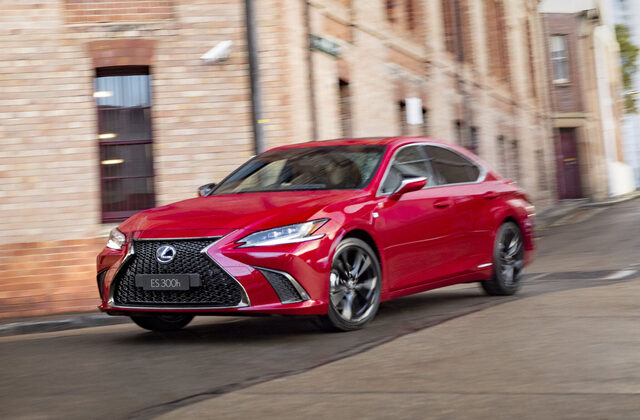
The growth in SUV sales has seen a corresponding decline in demand for traditional four-door sedans.
In the case of Lexus only two of the latter have survived, the company’s flagship luxury LS and the medium-large family ES.
The ES comes with the choice of the ES250 powered by a 2.5-litre petrol engine with outputs of 152 kW and 243 Nm names ES250, and the E300h with a 131 kW/221 Nm Atkinson Cycle petrol engine combined with a 88 Kw/202 Nm electric motor for a total of 160kW.
Both ES models come with the choice of Luxury or F Sport equipment levels, the ES300h adds a higher level Sports Luxury grade which was our test vehicle.
STYLING
We particularly like the spindle grille in this model. Some of the earlier efforts of Lexus at this fascinating shape just didn’t work to our eyes, but this one fits perfectly. The front of the ES spreads out far and wide visually.
The lower edge of the window line swoops up at the rear, and meets a downward swoop of the roofline. The lower area of the rear doors also parallels this, moving up from their rear edge to meet the taillights, then continues into the bootlid for a few centimetres.
INTERIOR
The ES300h is a full-on luxury vehicle with the interior trim made from high-class materials. It’s finished in three different coloured materials, which is a major improvement on the endless black-on-black that we see in so many cars, even upmarket ones.
This is a vehicle aimed at giving all occupants a comfortable life. Even the rear seats can be inclined and there’s a three-zone air conditioning.
There’s good legroom in the back, though if there’s a long-legged driver it may be necessary to talk to them and do a deal on space. Either that or sit the shortest rear passenger behind them. Your call…
The boot is generously long but the low set nature of this semi-sporty sedan makes it rather low in height.
The asymmetric shape of the dashboard makes a real stylish statement. More about it in the Driving segment of the review
INFOTAINMENT
The upgraded 12.3-inch touchscreen infotainment has proprietary sat-nav, DAB+ digital radio, wired Apple CarPlay and Android Auto smartphone mirroring together with Lexus Connected Services.
The screen projects forward from the dashboard to bring it within easier reach of the driver and eliminates the need to use the annoying and potentially dangerous sensitive touchpad that’s located in the centre console.
The driver’s screen combines digital and analogue gauges.
The Sports Luxury that we tested came with a 17-speaker Mark Levinson surround-sound system. Sound quality is excellent and we really enjoyed the feeling of luxury inside the cabin. It’s even more enjoyable in the very quiet interior of the Lexus than in lesser cars with a similar system.
ENGINES/TRANSMISSIONS
This is where it gets really interesting. The Lexus ES300h has a 2.5-litre four-cylinder Atkinson-cycle high-compression petrol engine producing 131kW. And an 88kW electric motor.
Peak torque is 221Nm on the petrol unit and 202Nm on the electric motor. The petrol doesn’t get to its torque peak until it reaches 3600rpm, the electric unit has its torque from one rpm. Yes, one rpm.
The Lexus has its front wheels driven through a continuously variable transmission.
SAFETY
The Lexus ES range received a five-star ANCAP when tested in September 2021.
Standard features include 10 airbags including knee airbags for the driver and front passenger. There are chest and head bags across its two seating rows.
There’s also autonomous emergency braking including junction assist, emergency steering assist for collision avoidance, lane-departure and blind-spot warning, rear cross-traffic alert, parking support brake with vehicle and object detection.
Child occupant protection top tethering and IsoFix child seat anchors.
DRIVING
Acceleration is instantaneous, you move the accelerator and the Lexus gets up and goes. This is one of the best features of all electric vehicles, be they hybrid or full electric.
It doesn’t slow as quickly as we like when we backed off on the pedal. But you do become used to this after a period of time at the wheel. Regular drivers of any vehicle with electric power soon adapt to this.
Fuel consumption from the ES 300h was impressively low, sitting around 5.3 litres per 100km during our week behind the wheel, just 0.5 L/100km above the listed figure.
Ride and handling will suit the typical buyer in being comfortable rather than sporty. Having said that it handles bends well and on the few times we tested it close to its limits around corners on our standard ‘official’ test route it responded well and gave us good feedback.
SUMMING UP
Lexus ES300h is a beautifully designed and built Japanese machine from a company that has specialised in hybrid and electric vehicles for many decades. It’s very much deserving of a place on your shopping list if you want to minimise climate change, and also enjoy peaceful motoring.
Lexus and its parent company Toyota are past masters at petrol-electric hybrids, with a history stretching back well over 20 years. They continue to add more performance, at the same time reducing emissions.
RATINGS:
Looks: 9/10
Performance: 8/10
Safety: 9/10
Thirst: 9/10
Practicality: 7/10
Comfort: 8/10
Tech: 8/10
Value: 8/10








